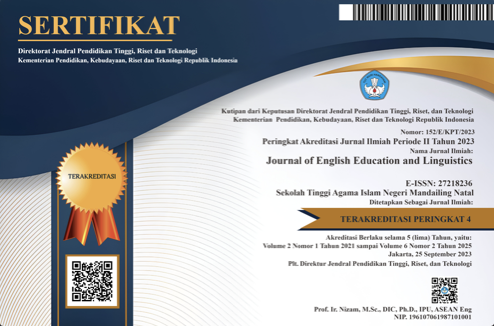DEVELOPMENT OF WORDWALL WEBSITE MEDIA FOR TEACHING VOCABULARY
DOI:
https://doi.org/10.56874/jeel.v5i1.1819Keywords:
Development, Wordwall Website, learning media, vocabularyAbstract
The use of learning media will facilitate teachers and students in the English learning process. One of the learning media that can be used is Wordwall. This research aims to develop materials using learning media based on the Wordwall Website and analyze the development results related to its suitability for vocabulary teaching. The subjects of this study were students of grade 10-2 at Madrasah Aliyah Sirojut Tholibin. The research employed the Research and Development (R&D) method. The development model used in this research was ADDIE which consists of five steps: Analysis, Design, Development, Implementation, and Evaluation. In the development process, there was the involvement of instrument experts, product experts, and material experts before the media was tested on students. Each result provided by the expert was used as material for improvement. The validation results from instrument experts amounted to 80%, product experts 90%, and material experts 78%. It means that the learning media developed is "valid" to be tested on students as learning media. After the trial process, students gave responses with an average percentage of 84.3%. It means that the media is also "valid" to be used to help improve their vocabulary and learning motivation in English lessons.
References
Chasanah, N., Widodo, W., & Suprapto, N. (2022). Pengembangan Instrumen Asesmen Literasi Sains Untuk Mendeskripsikan Profil Peserta Didik. PENDIPA Journal of Science Education, 6(2), 474–483. https://doi.org/10.33369/pendipa.6.2.474-483
Creswell, J. W., & Creswell, D. J. (2018). Research Design: Qualitative, Quantitative, and Mixed Methods Approaches (Fifth). Sage.
Dalimunthe, A., Affandi, M., & Suryanto, E. D. (2021). Pengembangan Modul Praktikum Teknik Digital Model Addie. Jurnal Teknologi Informasi & Komunikasi Dalam Pendidikan, 8(1), 17. https://doi.org/10.24114/jtikp.v8i1.26777
Evandri. (2024). Pengembangan Media Pembelajaran Interaktif Berbasis Game Wordwall Untuk Meningkatkan Motivasi Dan Minat Belajar Siswa Sekolah Dasar Development of Interactive Learning Media Based on Wordwall Games To Increase Motivation and Elementary School Students’ Le. Journal of Education and Culture (JEaC), 04, 84–102.
Fayrus, & Slamet, A. (2022). Model Penelitian Pengembangan (R n D).
Fitria, D., Husaeni, A., Novia, D., Husaeni, A., Bayu, A., Nandiyanto, D., & Rokhman, M. (2024). How Technology Can Change Educational Research ? Definition , Factors for Improving Quality of Education and Computational Bibliometric Analysis. ASEAN Journal of Science and Engineering, 4(2), 127–166. https://doi.org/http://dx.doi.org/10. 17509/xxxx.xxxx
Ghani, M. T. A., & Daud, W. A. A. W. (2018). Adaptation of Addie Instructional Model in Developing Educational Website for Language Learning. Global Journal Al-Thaqafah, 8(2), 7–16. https://doi.org/10.7187/GJAT122018-1
Gumelar, R. E. (2018). The Effect of Teaching Techniques (Storytelling and Show-and-Tell) and Students’ Personality on Students’ Speaking Skill. Journal of English Education Studies, 1(1), 8–19. https://doi.org/10.30653/005.201811.9
Hasan, M., Milawati, Darodjat, Khairani, H., & Tahrim, T. (2021). Media Pembelajaran. In Tahta Media Group.
Igir, G. P., Liando, N. V. F., & Andries, F. A. (2024). The Effectiveness of Using Wordwall.Net as Web-Based Learning to Enrich the Vocabulary of The Eighth-Grade Students at Smp Negeri 1 Tombariri. JoTELL Journal of Teaching English, Linguistics, and Literature, 3(3), 363–375.
Ingratubun, C. F., Pelenkahu, N., & Liando, N. V. F. (2024). The Analysis of the Students Learning Difficulties in Vocabulary at SMP Negeri 7 Satap Langowan Christin. JoTELL Journal of Teaching English, Linguistics, and Literature, 3(3), 346–362.
Kariyati, A., & Kusumaningrum, I. (2021). Development of the Wordwall Game for Learning Mandarin Vocabulary for Grade Vi Elementary School. International Journal of Educational Dynamics, 4(1), 101–107. http://ijeds.ppj.unp.ac.id/index.php/IJEDS/article/view/399
Kim, S., Kim, J., & Choi, J. (2020). Development and Application of a Forest Education Program Using the ADDIE Model. Journal of Forest and Environmental Science, 36(3), 243. https://doi.org/10.7747/JFES.2020.36.3.243
Lenaini, I. (2021). Teknik Pengambilan Sampel Purposive Dan Snowball Sampling. HISTORIS: Jurnal Kajian, Penelitian & Pengembangan Pendidikan Sejarah, 6(1), 33–39. http://journal.ummat.ac.id/index.php/historis
Mesra, R. (2023). Research & Development Dalam Pendidikan. In Mifandi Mandiri Digital Redaksi.
Muruganantham, G. (2015). Developing of E-content package by using ADDIE Model. International Journal of Applied Research, 1(3), 52–54. www.allresearchjournal.com
Nissa, S. F., & Renoningtyas, N. (2021). Penggunaan Media Pembelajaran Wordwall Untuk Meningkatkan Minat Dan Motivasi Belajar Siswa Pada Pembelajaran Tematik Sekolah Dasar. Educenter : Jurnal Ilmiah Pendidikan, 3(5), 2854–2860. https://jurnal.arkainstitute.co.id/index.php/educenter/index
Pradini, P. C., & Adnyayanti, N. L. P. E. (2022). Teaching English Vocabulary to Young Learners with Wordwall Application: An Experimental Study. Journal of Educational Study, 2(2), 187–196. https://doi.org/10.36663/joes.v2i2.351
Setyaningrum, R. W., Sabilah, F., & Sumarsono, P. (2020). Innovative Design for Pre-Service English for Young Learners (EYL) Teachers Education With Indonesian Setting. 477(Iccd), 621–625. https://doi.org/10.2991/assehr.k.201017.137
Suyono, S. (2021). The Development of Flash Interactive Learning Media in Improving English Speaking Skills of Grade X At SMA Negeri 16 Medan. Budapest International Research and Critics in Linguistics and Education (BirLE) Journal, 4(1), 145–157. https://doi.org/10.33258/birle.v4i1.1568
Tobaharu, W. (2019). Improving students vocabulary through Blindfold game at the seventh grade of mts al mawasir Padang kalua lamasi. http://repository.iainpalopo.ac.id/id/eprint/2681/1/WAHYUNI T.pdf
Downloads
Published
Issue
Section
License
All articles published in the Journal of English Education and Linguistics are licensed under a Creative Commons Attribution-ShareAlike 4.0 International (CC BY-SA) license. This means anyone is free to copy, transform, or redistribute articles for any lawful purpose in any medium, provided they give appropriate attribution to the original author(s) and Journal of English Education and Linguistics, link to the license, indicate if changes were made, and redistribute any derivative work under the same license.
Copyright on articles is retained by the respective author(s) without restrictions. A non-exclusive license is granted to the Journal of English Education and Linguistics to publish the article and identify itself as its original publisher, along with the commercial right to include the article in a hardcopy issue for sale to libraries and individuals.
Although the conditions of the Creative Commons Attribution-ShareAlike 4.0 International (CC BY-SA) license do not apply to authors (as the copyright holder of your article, you have no restrictions on your rights), by submitting to the Journal of English Education and Linguistics, authors recognize the rights of readers and must grant any third party the right to use their articles to the extent provided by the license.

This work is licensed under a Creative Commons Attribution-ShareAlike 4.0 International License.








